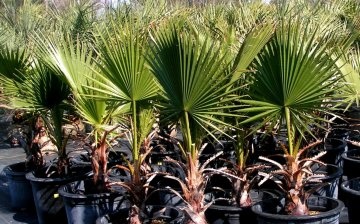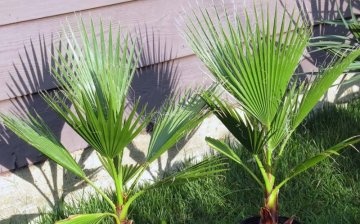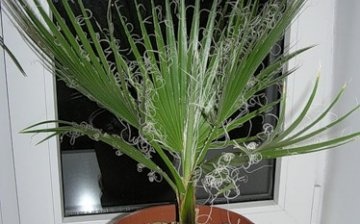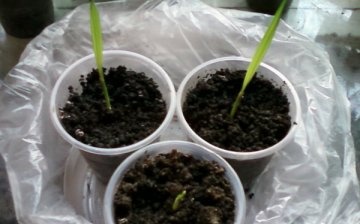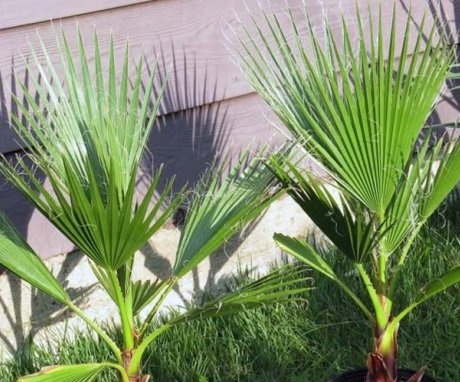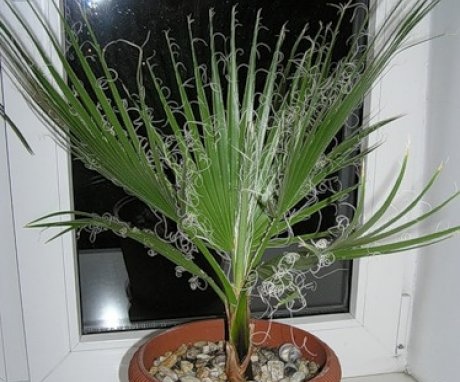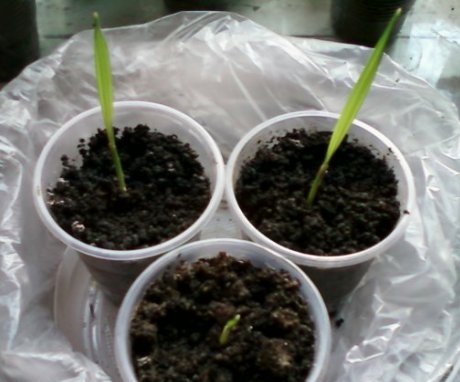Washingtonia filamentous: description of the plant and features of cultivation
Washingtonia threadbare is an exotic highlight for a familiar interior. Knowledge of the basic rules of caring for decorative deciduous plants is the key to their successful cultivation. In comfortable conditions, washingtonia filamentous will actively grow at home, and not only in a greenhouse.
Content:
- Washingtonia thread: description
- Main requirements for conditions of detention
- Features of transplantation and reproduction
Washingtonia thread: description
The culture is a large palm from the Arekov family. The plant owes its name to the first American president, George Washington. There are only two representatives of the Washingtonia clan: Washingtonia is thread-bearing and Washingtonia is powerful. It is quite difficult to confuse the species, since they have a different shade of leaf stalks. In the first plant, they are gray-green, and in the second, they are brownish.
In nature, the palm tree is found in the subtropical zone of Mexico and the South of the United States. For a palm tree, the conditions of the Mediterranean climate are natural. At home, she is able to withstand a short frost down to -120C.
Features of the plant:
- Filamentous Washingtonia is an evergreen plant, reaching a height of 15 m.
- The trunk diameter is 1 m.
- Luxurious leaves on long stalks resemble a fan cut to the middle. They consist of 80-90 segments, between which twisted threads are visible.
- Under natural conditions, wilted leaves remain on the trunk and cover it. Such "clothing" becomes an excellent refuge for birds and rodents. Gardeners remove foliage so that the appearance of the palm tree is not affected.
- Inflorescences are discarded only by mature plants. Long (about 3 m) stems are crowned with white bisexual flowers. Later, black nutritious berries appear in their place, which birds love to feast on.
- At home, this culture is eaten. The seeds are used to make flour, and the petioles are boiled or eaten raw. Leaves are the source of fiber from which baskets are woven.
The ideal conditions for growing Washingtonia are created in greenhouses.
It is quite difficult to cultivate it in a house or apartment. The first problem is the size of the plant. You will also have to think about the abundance of light and a cool winter. Washingtonia threadbare is a luxurious palm tree that designers use to add a special tropical flavor to the interior.
Main requirements for conditions of detention
Indoors, the plant will not grow more than 2-3 m.For optimal development, palm trees are provided with:
- Sufficient illumination.
- Suitable temperature conditions.
- Regular watering.
- Timely feeding.
- Normal air humidity.
The culture is very light-requiring. She loves the sun. Develops well on East and West facing windows. On the south side, young palms are at risk of overheating. They will suffer without fresh air during the hot season. With a lack of natural light, artificial devices are used. The palm tree is placed under a fluorescent lamp for 16 hours a day. The distance between it and the plant is 30-60 cm.
In summer, Washington will enjoy the balcony, outdoor terrace or patio. The main thing is the absence of dampness.
Rainy weather can harm her.The optimum moisture content for a flower is 55-75%. If the air is dry and hot, spraying will help the plant. In winter, it is enough to wash the leaves.
In summer, the optimal temperature regime for a palm tree is 20-280C, and in winter - 5-100C. A cool rest is essential to her. Warmth and low light in winter will cause the exhaustion and destruction of Washington. If the flower simply has nowhere to take out of the apartment at this time of year, then, at least, it is placed closer to the window and fenced off from the battery. The palm tree needs ventilation, but the draft is its enemy.
Watering the plant:
- Water the culture in moderation.
- It is contraindicated for both overdrying of the roots and strong waterlogging of the soil.
- Drainage will help prevent fluid stagnation.
- The plant is watered with settled water at room temperature.
- In winter, when it "rests" in a cool room, special care should be taken in terms of watering.
- The plant is given attention when the earthen coma dries out.
Summer feeding - once every 14 days mineral fertilizer... Kemira Lux or Aquarin will do. You can apply compositions for palm trees. Pocon, Bona Forte are recommended.
With the approach of winter, the frequency of feeding Washington is gradually reduced. In the cold season, she does not need them. Keeping a palm tree in a comfortable environment will ensure its normal development and health.
Features of transplantation and reproduction
Washinia filamentary is determined in a new container in late winter or early spring. As with other palms, it needs a tall tub. Low and wide pots will not work. Adding perlite to the substrate will ensure adequate drainage.
Suitable fillings for plant containers:
- Dense, clay-soddy, slightly alkaline soil.
- A mixture of sod, leaf, humus soil (2 parts each) and sand (1 part).
- Leafy, humus, turfy soil and sand in a ratio of 2: 2: 3: 1. This soil is suitable for older palms.
- Earth mix "For dracaena".
- Substratum "For yucca"or" For palms ".
The transfer method is transshipment. They work carefully, trying not to injure the roots.
Young Washingtonians change their soil every year. When transplanting adult plants, the measure of filling the container with roots is taken into account. Grown palms disturb 1 time in 2-3 years. In plants that have reached 10 years of age, they simply renew the topsoil.
Plant propagation:
- Washingtonia filamentous is propagated by seeds, since lateral shoots do not develop in it.
- They are sown in a mixture of peat, sand and sphagnum (1: 1: 1). Sod or compost soil can be used. For disinfection, it is subjected to heat treatment (in a microwave or oven).
- The planting material should be immersed in the cooled substrate by 0.5-1 cm.
- The ideal temperature for sprouting is 250C. Heating from below is recommended. The soil must not be allowed to dry out or be waterlogged.
If all goes well, the seeds will germinate in 1 to 2 weeks. Small palms develop several long roots: soon you will have to start transplanting them into a deep container.
In a favorable environment, seedlings are actively developing. 4-5 leaves are formed per year.
Using seeds, you can propagate a palm tree and cultivate it in suitable soil.
One of the problems of growing washingtonia thread in an apartment is its large size. On the terrace, in the spacious hall, the palm tree will play the role of the central plant.
More information can be found in the video.



